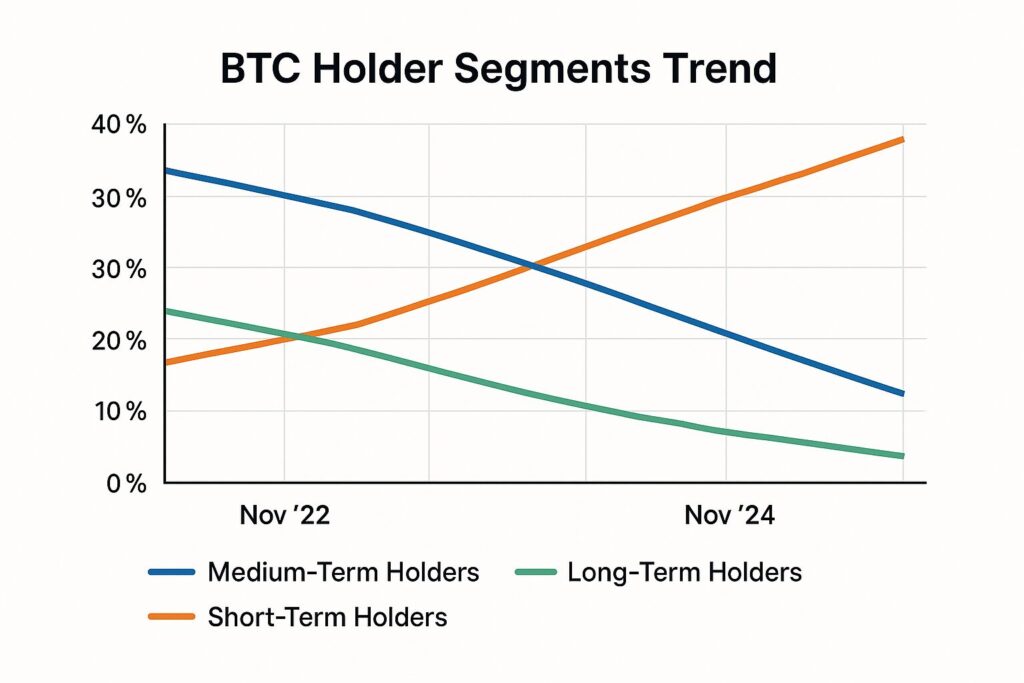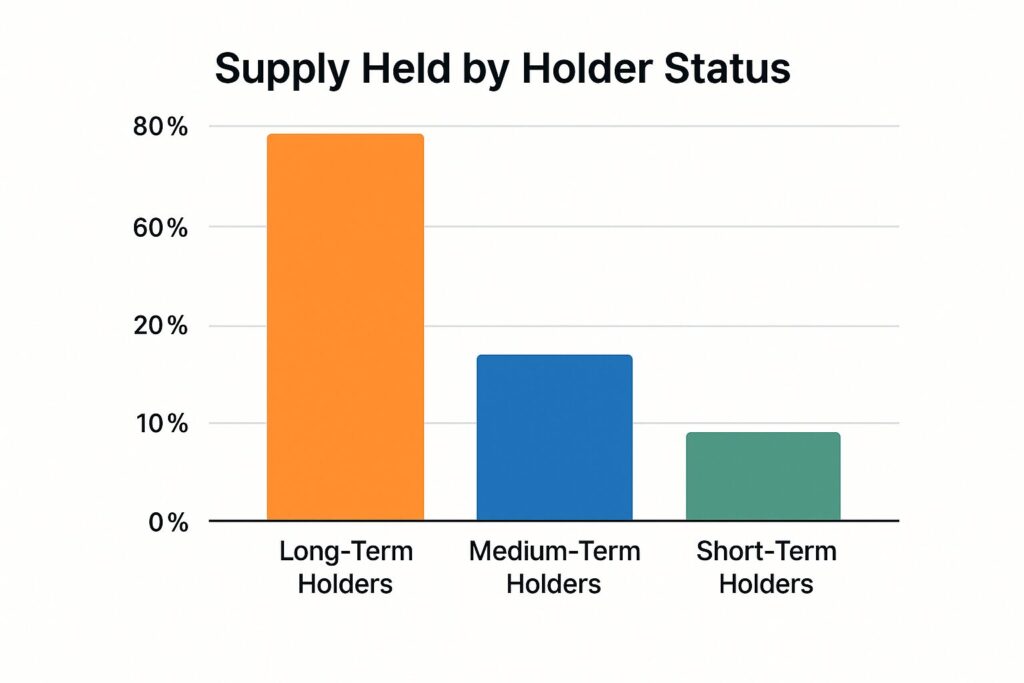
Main Points :
- Medium-term Bitcoin holders (3–5 years) are responsible for most of the recent selling pressure.
- Long-term holders (5+ years) continue accumulating, showing no signs of capitulation.
- Institutional outflows from Bitcoin ETPs reached 49,300 BTC since the October flash crash.
- A “Satoshi-era whale” moved and sold $1.5B worth of BTC, shocking the market.
- Retail investors shifted aggressively into equity ETFs (~$96B in November).
- Despite recent volatility, long-term fundamentals remain bullish.
- Strategic investors may find opportunity zones if BTC stays below estimated production cost ($94,000 — JPMorgan).
Introduction
The Bitcoin market has recently undergone a sharp and emotionally charged correction—one marked by sudden long-liquidations, large whale movements, ETF outflows, and a significant shift in investor behavior. However, according to a new report released by VanEck, the source of Bitcoin’s selling pressure is not the long-term, conviction-driven whale cohort often feared by the market. Instead, the core sellers are medium-term holders, specifically those who have held BTC for 3–5 years.
This distinction is critical. For investors seeking new crypto opportunities, sustainable income streams, and practical blockchain applications, understanding the behavior of different holder cohorts can reveal where real risk — and opportunity — lies.
This article summarizes the VanEck report, cross-references global market trends from The Block, JPMorgan, and other major institutions, and provides a forward-looking analysis aimed at strategic crypto investors.Chart Insertion (Insert Here: Chart 1)

1. Bitcoin’s Selling Pressure Is Coming From Mid-Term Holders, Not Long-Term Whales
VanEck’s report emphasizes a clear pattern:
- 5+ year holders (long-term) → continue to accumulate and show strong conviction
- 3–5 year holders (medium-term) → are selling aggressively and driving recent declines
Bitcoin held for over five years increased by 278,000 BTC compared to two years ago, reflecting both maturation of older coins and steadfast belief among early adopters.
Meanwhile, coins acquired during the 2020–2021 cycle, a period marked by speculative enthusiasm and new retail participation, saw a 32% reduction over the past two years. These mid-term holders resemble “cycle traders” — investors who buy during hype phases and cash out when sentiment shifts.
Despite a November sell-off triggered by a Satoshi-era whale liquidating $1.5B in BTC, large long-term whales holding 10,000–100,000 BTC only reduced holdings by 6% (6 months) and 11% (12 months) — moderate, but not capitulatory.
By contrast, smaller investors (100–1,000 BTC) increased their holdings by 9% and 23% over the same periods. This suggests retail and emerging whales view the correction as a buying opportunity.Chart Insertion (Insert Here: Chart 2)
2. Institutional Outflows: Bitcoin ETPs Shed 49,300 BTC Since October Flash Crash
Another major factor behind the price decline is institutional repositioning. Following the October 10 flash crash, Bitcoin ETP/ETF products experienced a net outflow of:
- 49,300 BTC,
- equivalent to roughly 2% of total assets under management.
These outflows reflect short-term risk-off positioning rather than structural loss of confidence. Historically, institutional ETF flows often lag price movements rather than predict them.
VanEck notes that despite headline concerns, long-term holders remain largely unaffected.
3. Extreme Fear Reaches Lowest Level Since March
Sentiment indicators show that the crypto market has entered a deep fear phase:
- Fear & Greed Index = Extreme Fear (lowest since March)
Sentiment-driven selloffs typically resolve quickly once weaker hands have exited. With long-term holders unmoved, structural risk appears limited.
Investor fear is amplified by macro uncertainties, including U.S. monetary policy and the reported “Satoshi-era whale liquidation.”Chart Insertion (Insert Here: Chart 3)

4. JPMorgan: Retail Investors Fuel ETF Sell-Offs — NOT Crypto-Native Traders
JPMorgan’s November 20 report provides an additional dimension.
Their analysts argue that the recent drop below the estimated Bitcoin production cost ($94,000) was driven not by crypto-native speculators but by retail investors selling spot ETFs.
Key insights include:
- $4B in outflows from Bitcoin and Ethereum spot ETFs in November
- Retail investors moved $96B into equity ETFs in the same month
- If this pace continues, total inflows into equity ETFs could reach $160B by month-end
The data shows that investors are not turning bearish on risk assets overall, but rather rotating away from crypto ETFs into equities, likely due to macroeconomic uncertainty and Fed rate expectations.
JPMorgan cautions against misinterpreting ETF outflows as a broader collapse of market sentiment.
5. Mid-Term vs Long-Term Behavior: Who Actually Controls the Market?
Mid-Term Holders (3–5 years)
- Opportunistic, cycle-driven investors
- Accumulated heavily during the late 2020–2021 bull market
- Largest selling cohort during recent corrections
- Likely to continue selling if macro pressure persists
Long-Term Holders (5+ years)
- Strongest conviction group
- Historically responsible for initiating new bull cycles when accumulation peaks
- Increased holdings by 278,000 BTC over two years
- Unfazed by recent volatility
Large Whales (10,000–100,000 BTC)
- Small decrease (6–11%) over 6–12 months
- Short-term increase (last 30–90 days), possibly buying the dip
- Likely accumulating ahead of expectations of 2025 policy changes
6. Macro Factors: How U.S. Fed Policy and ETF Rotation Shape BTC Trends
Fed Rate Cut Expectations Decline
Strong U.S. employment data reduced the probability of a December rate cut.
This triggered:
- A broad risk-off sentiment
- Equity tech stocks falling
- Crypto markets moving in correlation
Retail Risk Rotation
Retail investors poured money into equities, not stablecoins or bonds.
This suggests:
- Risk appetite remains intact
- Crypto ETF selling is tactical, not structural
Bitcoin Under Production Cost
BTC dipping below JPMorgan’s estimated production cost (~$94,000) historically corresponds to bottoming zones.
7. What This Means for Strategic Crypto Investors
For investors seeking new digital assets, yield-generating opportunities, and blockchain utility tokens, the current environment creates compelling setups.
Key Opportunity Signals
- Long-term holders accumulating → long-term bullish
- Retail ETF selling → temporary supply pressure
- BTC below production cost → historical rebound zones
- Medium-term sellers nearly exhausted → supply thinning
- Whale accumulation in past 30–90 days → smart money positioning
Risk Considerations
- Macro volatility (U.S. rates, global equity corrections)
- ETF outflows may persist short-term
- Whale movements may temporarily impact sentiment
Nonetheless, structural fundamentals remain solid.
Conclusion: A Market Reset Poised for Long-Term Growth
The VanEck and JPMorgan analyses converge on the same message: The Bitcoin market is not collapsing — it is rebalancing.
Selling pressure is concentrated among medium-term holders, while long-term whales and new retail whales are accumulating. ETF outflows reflect retail rotation, not long-term bearishness.
For investors exploring new crypto opportunities, income-generating models, and blockchain practical applications, the current market offers both clarity and opportunity. With long-term conviction high and macro shocks moderating, the stage appears set for a more stable and potentially bullish environment heading into 2025.

